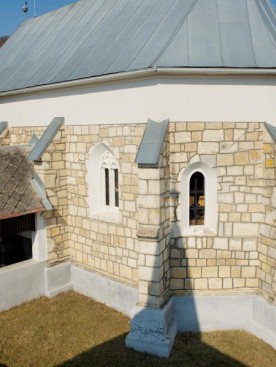The Calvinist Church – Nagymuzsaly
This settlement situated along the road connecting Berehove and Vynohrad’iv consisted in the Middle Ages of two separate parts. The population directly subordinated to the kings lived in the eastern part [Nagymuzsaly], whereas the western part belonged to a fortress [Kismuzsaly]. This church built of stone and dedicated to Saint John the Baptist was mentioned for the first time in 1337.
Nagymuzsaly was a market town (oppidum) in the 15th century. Its church consisting of a nave and a sanctuary having the same width still stands on the elevation overlooking the settlement. The building is enclosed, on its eastern end, by five sides of an octagon. The sanctuary is covered by a single-cell vault, while the nave by a double-cell vault.
On the western frontispiece one can see a portal spanned by a semi-circular arch. The gable above it was walled-up, however, it contains a relief representing a bearded(?) face, which was covered with lime coating, too.
A portal spanned by a lancet arch is located in the middle section of the southern wall. Both the nave and the sanctuary are ornamented with windows having tracery decorations.
On the inside of the church, one can observe a clear mark of its medieval origins: the lattice vault. The southern wall of the sanctuary is divided into two by a sedilia. Diagonal ribs unite the corners of the sanctuary with the cornerstone of the vault to which a disc without decorations had been added.
The majority of the architectural structures composing the present church could not belong to the edifice described in the early accounts, stemming from the 14th century. Only the chancel arch can be a remainder of the earlier church. The shape of the lattice vault is a rather infrequent solution, which was used only between 1430 and 1500. It can be presumed, that the church in the nearby Beregszász served as model.
The once extant settlement of Kismuzsaly had been destroyed in 1657 as a result of a retribution campaign initiated by Polish troops. The ruins of the church belonging to the latter village can be seen in the middle of a field located to the south of Nagymuzsaly’s western end.
Taking into account the importance of Kismuzsaly, its church had been built with a conspicuously exaggerated precision. This is the reason why the ruins of this edifice still stand: villagers were unable to take away the stones used for erecting its massive walls. The western portal was probably made in the stone-carving workshop of Berehove.
A sanctuary enclosed by five sides of an octagon is connected to the building’s nave having a rectangular base. A semi-circular chancel arch separates the sanctuary from the nave. Remains of the windows opened in the walls of the nave and the sanctuary can still be seen.
The church had been built, probably, during the second half of the 15th century.



















